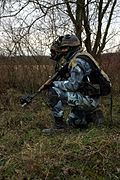This article needs additional citations for verification .(November 2009) |

An opposing force (alternatively enemy force, abbreviated OPFOR or OpFor) is a military unit tasked with representing an enemy, usually for training purposes in war game scenarios. The related concept of aggressor squadron is used by some air forces.
Contents
- Units
- Canada
- China
- France
- Republic of Korea
- Japan
- United States
- Gallery
- Personnel
- Vehicles
- Notes
- References
- Further reading
At a basic level, a unit might serve as an opposing force for a single scenario, differing from its 'opponents' only in the objectives it is given. However, major armies commonly maintain specialized groups trained to accurately replicate real-life enemies, to provide a more realistic experience for their training opponents. (To avoid the diplomatic ramifications of naming a real nation as a likely enemy, training scenarios often use fictionalized versions with different names but similar military characteristics to the expected real-world foes.)


































































